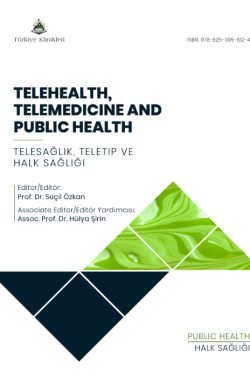Telehealth Experiences and Telehealth Policies Around the World
Asiye Çiğdem ŞİMŞEKa
aUniversity of Health Sciences Gülhane Faculty of Medicine, Department of Public Health, Ankara, Türkiye
Şimşek AÇ. Telehealth experiences and telehealth policies around the world. In: Özkan S, ed. Telehealth, Telemedicine and Public Health. 1st ed. Ankara: Türkiye Klinikleri; 2024. p.15-24.
ABSTRACT
In many countries of the world, thanks to remote health applications using advanced health systems, dependency on hospitals has gradually decreased, and instead, the use of mobile applications and health technologies that can serve 24 hours a day, 7 days a week and can be easily accessed by everyone has increased. When we look at the health investments of countries; countries that are transitioning to remote health systems are investing in health technologies. These investments have expanded the range of health services from a narrow area such as the hospital environment to wider segments and farther away (with telemedicine and mobile applications). In this way, health services can reach individuals regardless of time and space. In the digitalization process triggered by the COVID-19 pandemic, tele-medicine and tele-health service applications and artificial intelligence-supported services are systematized with legal regulations in many countries. When the telehealth journey of the countries is examined; it is thought that they have similar problems and regulatory frameworks are not clear, policy studies should be prioritized quickly and problems should be solved in order to reach all those in need. The legal arrangements to be made in line with the country policies will continue until the concerns about reimbursement, confidentiality and security of personal data and patient privacy are addressed.
Keywords: Telemedicine; health policy; mobile applications
Kaynak Göster
Referanslar
- Al-Alawy K, Moonesar IA. Perspective: Telehealth - beyond legislation and regulation. SAGE Open Med. 2023;11:20503121221143223. [Crossref] [PubMed] [PMC]
- Omboni S, Padwal RS, Alessa T, Benczúr B, Green BB, Hubbard I, et al. The worldwide impact of telemedicine during COVID-19: current evidence and recommendations for the future. Connect Health. 2022;1:7-35. [Crossref] [PubMed] [PMC]
- Zelmer J, Ronchi E, Hyppönen H, Lupiáñez-Villanueva F, Codagnone C, Nøhr C, et al. International health IT benchmarking: learning from cross-country comparisons. J Am Med Inform Assoc. 2017;24(2):371-9. [Crossref] [PubMed] [PMC]
- Stowe S, Harding S. Telecare, telehealth and telemedicine. Eur Geriatr Med. 2010;1(3):193-7. [Crossref]
- Şimşek AÇ, Şenlik ZB, Özdemirkan T, Kotanoğlu M. Telehealth and telemedicine in health service presentation. Türkiye Sağlık Okuryazarlığı Dergisi 2022;3(3):153-60.
- Şimşek AÇ, Kotanoğlu MS, Gül H, Çakmak D, Musaonbaşıoğlu S, Bulut YE, et al. Pandemi iletişiminde COVID-19 çağrı karşılama merkezlerinin önemi: Ankara örneği. Turk Hij Den Biyol Derg. 2023;80(2):159-70. [Crossref]
- Birinci Ş, Ülgü MM, Feyzioğlu SB, Sebik NB, Yasin Yarbay Y. Healthcare services in Türkiye pursuant to the regulation on provision of remote healthcare services: a traditional compilation study. Türkiye Klinikleri J Health Sci. 2023;8(3):514-22. [Crossref]
- Yüksel G. Tele-tıp, tele-sağlık uygulamaları nedir, ne değildir?, 26.01.2021. [Link]
- Çavdar P. Türk hukuku ve Avrupa birliği direktifleri ışığında tele-tıp. SÜ Hukuk Fakültesi Dergisi. 2022;30(2):755-83. [Crossref]
- Ustamehmetoğlu G. Elderly care applications ın a smart world. Fenerbahce Univ J Health Sci. 2021;1(1):53-61.
- Seçe MB. Telerehabilitation in Elderly Care. J Geriatr Sci. 2022;5(2):46-55. [Crossref]
- Prilukov M, Martynov A, Bundin M, Umanskaya V. Problems of legal regulation of telemedicine: Russian and international experience. 2019 Sixth International Conference on eDemocracy & eGovernment (ICEDEG). [Crossref]
- Hsieh KC, Hjelm NM, Lee JCK, Aldis JW. Telemedicine in China. Int J Med Inform. 2001;61(2-3):139-46. [Crossref] [PubMed]
- Takahashi T. The present and future of telemedicine in Japan. Int J Med Inform. 2001;61(2-3):131-7. [Crossref] [PubMed]
- Akiyama M, Yoo BK. A Systematic Review of the Economic Evaluation of Telemedicine in Japan. J Prev Med Public Health. 2016;49(4):183-96. [Crossref] [PubMed] [PMC]
- Antoniotti NM, Drude KP, Rowe N. Private payer telehealth reimbursement in the United States. Telemed J E Health. 2014;20(6):539-43. [Crossref] [PubMed]
- Chellaiyan VG, Nirupama AY, Taneja N. Telemedicine in India: Where do we stand? J Family Med Prim Care. 2019;8(6):1872-6. [Crossref] [PubMed] [PMC]
- Paris Agence Régionale de Santé Ile-de-France. Projet ETAPES.
- Elder L, Clarke M. Past, present and future: experiences and lessons from telehealth projects. Open Med. 2007;1(3):e166-70.

